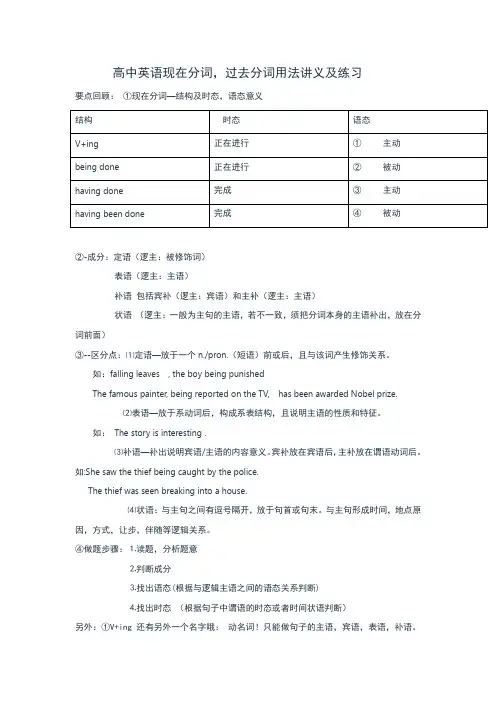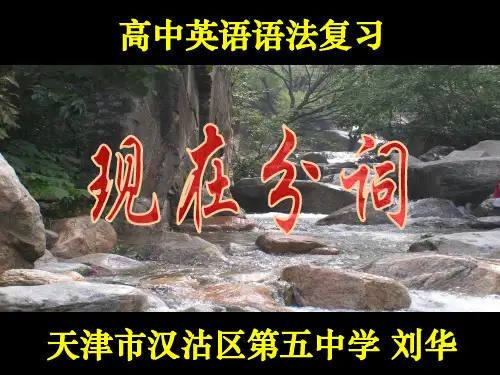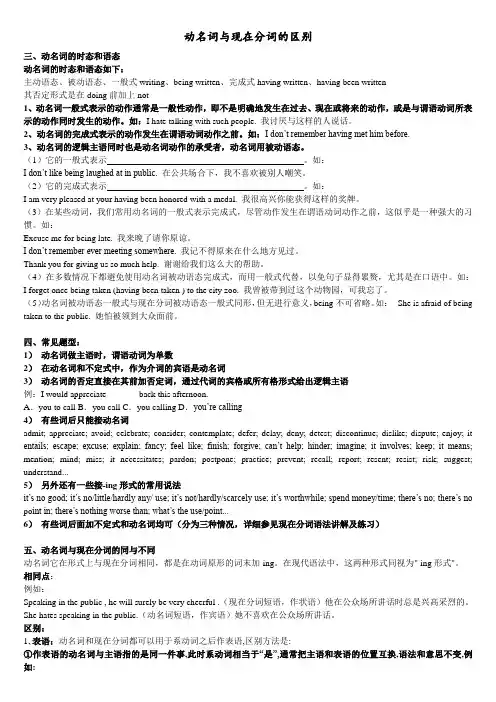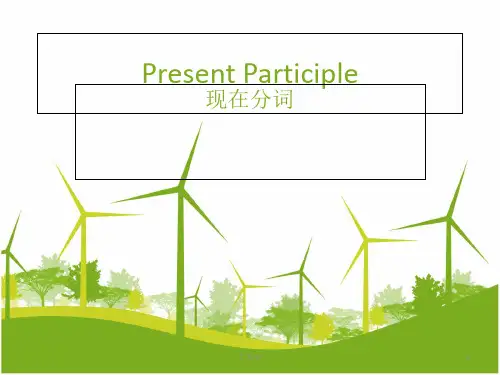高中英语现在分词用法练习题
- 格式:docx
- 大小:32.63 KB
- 文档页数:9

高中英语词法之现在分词考点大全笔记单选题1、The digital age ________ us to find friends ________ the same interests.A.enabled ; to shareB.enabled ; sharedC.enables ; sharingD.enable ; share答案:C解析:考查时态及非谓语动词。
句意:数字时代使我们能够找到志趣相投的朋友。
根据句子结构,第一空考查谓语动词,第二空考查非谓语动词。
根据句意,此句描述一般事实,故用一般现在时。
主语The digital age是单数,谓语动词用单三,第一空填enables;friends与share是主谓关系,故用现在分词,作定语,故填sharing,故选C。
2、A group of Tibetan antelopes is moving under the bridge, with some________to eat grass.A.stoppedB.to stopC.stoppingD.being stopped答案:C解析:考查现在分词。
句意:一群藏羚羊在桥下移动,其中一些停下来吃草。
分析句子可知,后面为with+名词/代词+分词作状语,设空处的分词和some之间为主动关系,应用现在分词。
故选C项。
3、________ my daughter was going off to sleep, I asked if she’d li ke that little doll on her bed. A.SeeingB.To seeC.SeeD.Seen答案:A解析:考查非谓语动词。
句意:看到我女儿要去睡觉,我问她是否想要那个小娃娃在床上陪她。
分析句子结构可知,“I asked if she’d like that little doll on her bed.”是主句,所以空处是非谓语动词作状语,动词see(看到)的逻辑主语是主句主语I(我),且二者之间是主动关系,应用现在分词形式,故选A。


高中英语现在分词,过去分词用法讲义及练习要点回顾:①现在分词—结构及时态,语态意义②-成分:定语(逻主:被修饰词)表语(逻主:主语)补语包括宾补(逻主:宾语)和主补(逻主:主语)状语(逻主:一般为主句的主语,若不一致,须把分词本身的主语补出,放在分词前面)③--区分点:⑴定语—放于一个n./pron.(短语)前或后,且与该词产生修饰关系。
如:falling leaves , the boy being punishedThe famous painter, being reported on the TV, has been awarded Nobel prize.⑵表语—放于系动词后,构成系表结构,且说明主语的性质和特征。
如:The story is interesting .⑶补语—补出说明宾语/主语的内容意义。
宾补放在宾语后,主补放在谓语动词后。
如:She saw the thief being caught by the police.The thief was seen breaking into a house.⑷状语:与主句之间有逗号隔开,放于句首或句末。
与主句形成时间,地点原因,方式,让步,伴随等逻辑关系。
④做题步骤:⒈读题,分析题意⒉判断成分⒊找出语态(根据与逻辑主语之间的语态关系判断)⒋找出时态(根据句子中谓语的时态或者时间状语判断)另外:①V+ing 还有另外一个名字哦:动名词!只能做句子的主语,宾语,表语,补语。
② V+ed 又名: done ,过去分词。
成分,区分点,做题步骤均跟V+ing 相同。
不同点在于:V+ed 时态上表示已经完成,语态上表示被动。
如: the injured workers 受伤的工人。
(单个分词前置)a book written by Lu Xun (分词短语后置)a broken glass 一个被打破了的杯子。
(及物动词的过去分词表示被动、完成)a retired teacher (不及物动词的过去分词只表示完成)小练笔:看看你理解掌握了哪些?一.比较下列1.2.3题,选出最合适的答案1._____ from the top of the TV tower, we can get a beautiful sight of most of the city.A. To seeB. SeenC. SeeingD. See2.____ from the top of the TV tower, the city got more beautiful.A. To seeB. SeenC. SeeingD. See3._____ from the top of the TV tower, and we can get a beautiful sight of most of the city.A. To seeB. SeenC. SeeingD. See再试试其他题吧:1. All things _____, the planned trip will have to be called off.A. be consideredB. consideringC. having consideredD. considered2. _____ in 1613, Harvard is one of the most famous universities in the United Stated.A. being foundedB. FoundedC. It was foundedD. Founding3. _____ more attention, the tree could have grown better.A. GivenB. To giveC. GivingD. Having given4. ____ alone in the dark room, the little boy was so frightened as to cry.A. LeavingB. LeftC. To be leftD. Having left5. ______ in a friendly way, their quarrel came to an end.A. Being settledB. Having settledC. SettledD. Settling6. He must be angry, for we heard the glass ____ on the floor.A, being broken B. break C. to be break D. broken7.____in this way, the situation doesn't seem so disappointing. (00,1)A) To look B) Looking at C) Looked at D) To be looked at8, You will see this product ____ wherever you go. (00,6)A) to be advertised B) advertised C) advertise D) advertising9.From the dates ____ on the plates, we decided that they were made in Song Dynasty.A) marking B) having been marked C) marked D) to be marked10.She stood by the window, ____.A) thinking B) think C) thought D) thinks11.____ to meet anybody, he went in from the back door.A) Not wishing B) Wishing C) Not wished D) No wishing12.The old man came upstairs with great strength, his right hand ____ a stick for support.A) held B) holding C) being holding D) was holding13.____ three times in a row, the boxer decide to give up fighting.A) having defeated B) To have defeatedC) having been defeated D) To have been defeated14.I understood you were third-year students ____ in English.A) who majors B) who major is C) have majored D) majoring15.A cool rain was falling, ___ with snow. A) mixed B) mixing C) to mix D) having mixed16.____ by the police, the kidnappers had no choice but to surrender.A) Surrounded B) Surrounding C) having surrounded D) To be surrounded17.All the exam papers ____, the teacher sent the class home.A) having been handed in B) having hands in C) handing in D) being handed in18.___ in Beijing for quite a few years, Mr. Park had little difficulty understanding Chinese.A) having lived B) Lived C) Living D) To live19.Any packet ____ properly will not be accepted by the post office.A) not to be wrapped B) not being wrappedC) not wrapped D) not having been wrapped20.He was sitting in the chair, ____ a book. A) read B) was reading C) readingD) with reading。


【高中英语】现在分词的完成式用法总结
一、现在分词的完成式表示其动作在谓语动词的动作之前完成。
1.做完家务后,孩子们开始看电视。
做完作业后,这个小女孩开始看电视。
2.在北京生活多年,carterknewthecitywell。
因为在北京住了多年,卡特对这个城市很熟悉。
被动式
二、现在分词的被动形式表明其逻辑主语是现在分词行为的接受者。
a.现在分词的一般被动式。
如:
1.这座大楼是一座露天图书馆。
正在建的那栋楼是我们的图书馆。
2.正在讨论的问题非常重要。
正在讨论的问题非常重要。
b、现在分词完全被动。
例如:
1.havingbeenwarnedbytheteacher,thestudentsdidn'tmakesuchmistakes.
在老师警告他们之后,学生们不再犯这样的错误了。
2.havingbeentoldmanytimes,hestilldidnotknowhowtodoit.
他被告知多少次了,但他仍然不知道该怎么办。
三、现在分词的一般式通常表示其动作与谓语动词的动作同时发生。
如:
1.她正在读小说。
她坐在那里看小说。
2.一个孩子学会了经常摔倒。
学走路的小孩常常跌跤。
一般动词的动作有时发生在现在分词之前。
例如:
goingintotheroom,heshutthedoor.
当他走进房间时,他把门关上了。

(每日一练)2022届高中英语现在分词知识汇总大全单选题1、That kind of ice-cream ________like a mixture of banana and strawberry is delicious. A.tastedB.tastesC.tastingD.being tasted答案:C解析:考查动词正确形式辨析。
句意:那种尝起来像香蕉和草莓的混合味道的冰淇淋很好吃。
A.tasted (品尝;尝起来是)动词过去式/过去分词;B.tastes(品尝;尝起来是)动词单三形式; C.tasting(品尝;尝起来是)动词现在分词; D.being tasted(被品尝)动词ing形式的被动式。
分析句子主干,主语That kind of ice-cream,谓语动词 is,形容词 delicious.作表语。
可知该空为后置定语修饰名词 ice-cream ,表示“尝起来是,有着...口感的”,taste为系动词,无被动形式。
故选C项。
2、With the famous artist________ “Thank you” to the crowd, he left the hall quickly.A.finishing sayingB.finishing to sayC.to finish sayingD.finished saying答案:A解析:考查非谓语动词。
句意:当这位著名的艺术家对人群说完“谢谢”后,他迅速离开了大厅。
分析句子结构可知,本句使用了with复合结构,其构成为:with + n+非谓语动词,空处动词finish与其逻辑主语artist之间是主动关系,所以空处需要现在分词finishing作宾语补足语,finish doing sth.完成做某事,固定打破,所以此处需用finishing saying。
故选A。
3、When he saw the mists rising from the river and the soft clouds the mountain tops, he was reduced to tears.A.being surroundedB.surroundedC.surroundingD.to surround答案:C解析:考查现在分词。

高中英语语法复习天津市汉沽区第五中学刘华态主动态被动态式一般式1.being2.doingbeing done完成式having done having been done 否定式1.not being2.not doing3.not having done1.not being done2.not having beendone现在分词的形式现在分词短语的构成•1、现在分词有自己的宾语The teacher entered holding some books.•2、现在分词有自己的状语We saw a boat coming slowly towards us.•3、现在分词有时有它单独的逻辑上的主语(亦称独立主格结构)Mother being ill, I had to stay at home.•表示主动的意义1、它与被修饰的中心词(作定语)the boy standing by the windowthe sleeping child2、它与句子的主语之间(表语或状语)The film is exciting.She sat by the road, crying loudly.3、它与自己的逻辑主语之间(独立主格)There being no bus, they had to walk home.•从时间意义来讲1、表示动作正在进行Do you know the man talking to the manager?2、表示经常性、习惯性或现在的状态的动作They live in a room facing south.Being a student,he was interested in books3、表示动作语谓语动词同时发生We worked there for a week, helping them to get in wheat.4、表示动作在谓语动词之前发生(一般用现在分词的完成式)Not having received an answer, he decided to write another letter to them.Having studied in the university for 3 years,he knows the way very well。



动名词与现在分词的区别三、动名词的时态和语态动名词的时态和语态如下:主动语态、被动语态、一般式writing、being written、完成式having written、having been written其否定形式是在doing前加上not1、动名词一般式表示的动作通常是一般性动作,即不是明确地发生在过去、现在或将来的动作,或是与谓语动词所表示的动作同时发生的动作。
如:I hate talking with such people. 我讨厌与这样的人说话。
2、动名词的完成式表示的动作发生在谓语动词动作之前。
如:I don‟t remember having met him before.3、动名词的逻辑主语同时也是动名词动作的承受者,动名词用被动语态。
(1)它的一般式表示。
如:I don‟t like being laughed at in public. 在公共场合下,我不喜欢被别人嘲笑。
(2)它的完成式表示。
如:I am very pleased at your having been honored with a medal. 我很高兴你能获得这样的奖牌。
(3)在某些动词,我们常用动名词的一般式表示完成式,尽管动作发生在谓语动词动作之前,这似乎是一种强大的习惯。
如:Excuse me for being late. 我来晚了请你原谅。
I don‟t remember ever meeting somewhere. 我记不得原来在什么地方见过。
Thank you for giving us so much help. 谢谢给我们这么大的帮助。
(4)在多数情况下都避免使用动名词被动语态完成式,而用一般式代替,以免句子显得累赘,尤其是在口语中。
如:I forget once being taken (having been taken ) to the city zoo. 我曾被带到过这个动物园,可我忘了。

高中英语:现在分词专项讲解【基础回顾】考点归纳:1.现在分词时态和语态2.作定语3.作表语4.作宾语补足语5.with复合结构6.作状语(和不定式的区别)7.独立主格结构8.评述性状语【基础必读】一、现在分词时态和语态:1.否定结构现在分词的否定式由“not+现在分词”构成。
例:Not knowing where to go, she went to the police for help.她不知道该往哪儿走,就去请警察帮助。
(现在分词一般式的否定结构) Not seeing John,I asked where he was.我看不见约翰,于是问他在何处。
(现在分词一般式的否定结构)Not being seen by anyone,the thief escaped.那个贼趁无人看见时逃跑了。
(现在分词被动式的否定结构)Not having done it right,I tried again.我由于没有做对,所以又试了试。
(现在分词完成式的否定结构)2.现在分词一般式1)现在分词的一般式通常表示其动作与谓语动词的动作同时发生。
例:She sat there reading a novel.她坐在那里看小说。
A little child learning to walk often falls.学走路的小孩常常跌跤。
2)现在分词的一般式所表示的动作有时在谓语动词的动作之前发生。
例:Going into the room,he shut the door.走进房间,他就关上了门。
3.现在分词完成式1)现在分词的完成式表示其动作在谓语动词的动作之前完成。
例:Having finished her homework, the little girl began to watch TV.做完作业后,这个小女孩开始看电视。
Having lived in Beijing for many years, Carter knew the city well.因为在北京住了多年,卡特对这个城市很熟悉。
高中英语词法之现在分词重点知识点梳理单选题1、______ an important decision more on emotion than on reason, you’ll regret it sooner or later. A.BasedB.Being basedC.BasingD.To base答案:C解析:考查非谓语动词。
句意:如果你做一个重要的决定时更多的是基于感情而不是理智,你迟早会后悔的。
分析句子可知,设空处在句中做状语,和主语之间是主动关系,应用现在分词,短语base...on意为“以...为基础”,故选C。
2、Although no deaths________ alligator attacks________ in Texas during the past 15 years, 17 people reported injuries last month.A.resulting in… were reportedB.resulted in… were reportedC.resulting from…have been reportedD.resulted from…have been reported答案:C解析:考查非谓语动词和时态语态。
句意:尽管在过去的15年里,德克萨斯州没有因鳄鱼袭击而死亡的报道,但上个月有17人受伤。
第一空result in表示“导致,结果是”,result from表示“起因于,由于”,结合后文“alli gator attacks”可知指由于鳄鱼袭击而造成的死亡,应用现在分词短语resulting from,作定语;第二空主语与谓语构成被动关系,结合后文during the past 15 years可知为现在完成时的被动语态。
故选C。
3、________ to go out alone, the retired president had to go for a walk with several bodyguards________him. A.Having warned not … followed B.Not being warned … accompaniedC.Not warned … to followD.Warned not … accompanying解析:考查非谓语动词。
v-ing 形式作状语和定语StepI. 让学生找出课文中含有v-ing 的句子。
1._________________________________________________2._______________________________________________.3._______________________________________________4._________________________________________________.StepII. 个人自主,后小组讨论分析找出的句子分别做什么成分.v-ing 形式作__________、__________________.StepIII. 讲解语法。
以讲义形式下发,学生需要提前预习。
◆v-ing 形式作定语单个的现在分词做定语放在被修饰词的前面,分词短语(doing)作定语放在被修饰词的后面,并且与被修饰词存在逻辑上的主谓关系。
表示主动或正在进行。
A running girl = a girl who is running 一个正在跑步的女孩The man sitting by the window is our headmaster.This is an interesting book.拓展:The meeting being held is of great importance.= The meeting that/which is being held is of great importance正在举行的那个会议非常重要。
◆v-ing 形式作状语1. 现在分词有一般式(doing)和完成式(having done)两种形式。
当现在分词所表示的动作与主句的谓语动词所表示的的动作同时进行,用现在分词的一般式;当现在分词所表示的动作发生在主句的谓语动词所表示的的动作之前,则用现在分词的完成式;. Walking in the park, she saw an old friend.(当她在公园散步时,他看到了一个老朋友。
1. Taking pictures___ very interesting.A. isB. areC. to beD. be2. _____ the bad news made him cry.A. HearB. HeardC. HearingD. Is hearing3. ____ a desert had always been a risk adventure.A. being crossedB. Having crossedC. CrossingD. To have crossed4. Before he came , I __ ' d finished the whole book.A. to readB. to have readC. readingD. read5. I always enjoy ___ to popular music at night.A. to listenB. listeningC. that I can listenD. if I can listen6. _______________________ We are considering a trip around the island.A. take b. to take C. to be taking D. taking7.I hope you don ' t mind ____ at your newspaper.A. I lookB. my lookingC. I lookingD. my to look8.When a man's heart stops ___ , _h_e dies.A. to beatB. beatingC. beatD. beaten9.I can ' t help _______ he is still alive.A. thinkingB. thinkC. to thinkD. thought of10.So far as I am concerned , I prefer reading ______ .A. than meatB. for joyC. instead of sleeping D to drinking11. It goes without _____ that knowledge is important.A. talkingB. tellingC. sayingD. mentioning12. we are looking forward ____ our friends next week.13. ________________________ H e spent a lot of money books and magazines.A. to seeB. to seeingC. to be seeingD. shall seeA. buyB. buyingC. to buyD. bought14. _____________________________ The silkworm is an insect worth .A. to knowB. knowingC. to be knownD. being known15.She went out without _____ good-bye to us.A. sayB. to sayC. sayingD. being said16. _____________________________ The curious student kept on questions.A. asksB. askingC. to askD. asked17. He is such a strange person; there' s _____ what he ' ll do next.A. no knowingB. not to knowC. not knownD. being unknown18. ______________________________________ W hen she heard the bad news, she burst ____________________________ .A. into cryingB. out to tearsC. cryingD. out crying19. You must never cross the street without _____ the light to turn green.A. waiting B/ to wait C. waiting for D. to wait for20. Scientists succeed ___ protein out of old newspapers.A. to makeB. at makingC. makingD. in making21.I became ____ after watching too much television.A. boredB. boringC. boreD. bores22.I felt __ by his interest in my new invention.A. encourage B to encourage C. was encouraged D. encouraged23.He sat there _____ a novel.A. readB. readingC. readsD. had read24. Don ' t wake up the _____ child.A. sleepB. sleptC. sleepingD. sleepy25.A proverb goes: ‘ A ___gsattohneers nomossA. rollB. rollingC. rolledD. rolls26.The heavy rain kept us ____ for two hours.A. waitB. waitedC. waitingD. to wait27.I found a dog ____ over by a car on the road.A. to runB. runC. ranD. running28. We found the baby __ on the floor.A. sleptB. sleepC. asleepD. sleeping29. _____________________ J ack saw a woman near the dog , so he walked up to her.A. stoodB. standsC. to standD. standing30. ___________________ They got their car at the garage.A. be washedB. washedC. being washedD. to have been washed31. __ with his report , I told him to write it all over again.A. DissatisfactoryB. Not being satisfiedC. Having not satisfiedD. Dissatisfying32. ____ our shoes in our hands , we crossed the stream.A. To carryB. CarryingC. CarriedD. Carry33. ____ my homework, I went home .A. Having finishedB. FinishedC. Being finishedD. Finish34. ___ the door unlocked, I went in.A. FindingB. FoundC. Had foundD. Have found35. ____ a careless fellow, he forget all about it.A. IsB. BeC. BeingD. Was36. ____ carefully, this letter is very beautifulA. TypeB. TypingC. TypedD. To typed37. Animals can do many amazing things when properly___.A. trainB. trainingC. trainedD. to train38. You must be careful when ___ on the highway.A. you drivingB. are drivingC. drivingD. you were driving 39.If , I will go to the party tonight.A. inviteB. invitingC. to inviteD. invited40. ______________________ Thousands of products from coal are now in daily use.A. madeB. makeC. makingD. to make41. Engines are machines ___ power or motion.A. produceB. producingC. producedD. which producing42. ___________________________________________________ During this battle some soldiers were wounded , and some ____________________ .A. missB. missedC. missingD. to miss 43Weather , we will have a picnic tomorrow.A. permitB. permitsC. permittedD. permitting44. _______________ T he vacation over , the students came back to school.A. isB. areC. wasD. being45. __ , we left off our work.A. After setting the sunB. Having set the sunC. The sun having setD. Being the sun set.46. ___ the painting, he gave a sigh of relief.A. FinishingB. Has finishedC. Being finishedD. Having finishedA. TellingB. Having toldC. Having been toldD. Have told47. ___ the way to take, the traveller went on his journey.11. The manager, it clear to us that he didn t agree with us, left the meeting 48. The United States has developed into a modern nation in a very short time___with many other countries.A. comparesB. comparingC. to compareD. compared49. _____________________________________________ When you find somethingin your writing that needs ___________________________ , youshould mark it on the paper.A. to be correctingB. correctC. to correctD. correcting50. ______________________ None of us objected to George to the birthday party.A. inviteB. invitingC. have invitedD. invited现在分词练习题(二)1. I can't stand __________ with Jane in the same office. She justrefuses ______ talking while she was working.A. working; stoppingB. to work; stoppingC. working; to stopD. to work; to stop2. Don ' t sit there ______ nothing. Come and help me with this table.A. doB. to doC. doingD. and doing3. The wild flower looked like a soft orange blanket ______ the desert.A. coveringB. coveredC. coverD. to cover4. Tom ' s never willing to alter any of his opinions. It 's no useA. to argueB. arguingC. arguedD. having argued5. The storm left, ______ a lot of damage to this area.A. causedB. to have causedC. to causeD. having caused6. _______ , the more expensive the camera, the better its quality8. I could ' t do my homework with all that noise _________A. going onB. goes onC. went onD. to go on9. He got well- prepared for the job interview, for he couldnopportunity.A. to loseB. losingC. to be lostD. being lost10. _______ f or many years, the two brothers can ' t recognize each other.A. Being separatedB. Having separatedC. Having been separatedD. To be separated room.A. who has madeB. having madeC. madeD. making12. I really can ' t understand ___________ her like that.A. you treatB. you to treatC. why treatD. you treating with him.A. General speakingC. Generally speaking7. “You can ' t catch me!A. runB. running B. Speaking generalD. Speaking generallyJane shouted, _______ away.C. to runD. ran___'__tthrieskg_o_o_d13. Everybody in the village likes Jack because he is good at telling and jokes.A. turning upB. putting upC. making upD. showing up14. Reading is an experience quite different from watching TV; there arepictures ______ in your mind instead of before your eyes!A. to formB. formC. formingD. having formed15. Don ' t leave the water ______ while you brushurytoeeth.A. runB. runningC. being runD. to run16. According to a recent survey, children spend up to 25 hours a week _______ .TVA. to watchB. to watchingC. watchingD. watch17. The man insisted ______ a taxi for me even though I told him I lived nearby.A. findB. to findC. on findingD. in finding18. Having been ill in bed for nearly a month, he had a hard time ______ the exam.A. passB. to passC. passedD. passing19. He looked around and caught a man _________ his hand into the pocket of a passenger.A. putB. to be puttingC. to putD. putting20. A cook will be immediately fired if he is found ______ i n the kitchen.A. smokeB. smokingC. to smokeD. smoked21. The discovery of new evidence led to ______ .A. the thief having caughtB. catch the thiefC. the thief being caughtD. the thief to be caught22. I couldn ' t find my key to the car when ________ home.A. leavingB. to leaveC. leftD. having left23. Though ______ money, his parents managed to send him to university.A. lackedB. lacking ofC. lackingD. lacked in24. _______ t o sunlight for too much time will do harm to one ' s skin.A. ExposedB. Having exposedC. Being exposedD. After being exposed25. I really appreciate ______ to relax with you on this nice island.A. to have had timeB. having timeC. to have timeD. to having time26. One learns a language by making mistakes and ______ them.A. correctB. correctingC. correctsD. to correct27. Mr Reed made up his mind to devote all he had to ______ some schools for poor children.A. set upB. setting upC. have set upD. having set up28. Sometimes new ideas have to be tested many times before _______ .A. accept fullyB. fully acceptingC. fully been acceptedD. being fully accepted11. The manager, it clear to us that he didn t agree with us, left the meeting29. _______ t his, you should have no trouble with the difficult work.A. KnowingB. If you are knowingC. From knowingD. If you had known30. Never ______ f aith in himself, the scientist went on with his research.A. losingB. to loseC. loseD. to be lost31. _______ m ade her very happy.A. Her parents will comeB. Her parents to comeC. Her parents cameD. Her parents ' coming32. The ______ girl was last seen _______ near the park.A. missing; playingB. missing; playC. missed; playD. missed; to play33. Tony was very unhappy for _____ to the party.A. having not been invitedB. not having invitedC. having not invitedD. not having been invited34. When he was young, he used to go there and watch ______ .A. to repair bikesB. bikes to be repairedC. bikes being repairedD. repairing bikes35. After the party the children were allowed to finish off the __________ sandwichesand cakes.A. remainingB. restC. leavingD. remained36. A policeman reported ______ an old lady risk _______ very fast on the highway.A. to see; drivingB. seeing; drivingC. to see; driveD. to see; driven37. I really appreciate ______ to help me, but I am sure that I can manage by myself.A. your offeringB. that you offerC. you to offerD. that you are offering38. What worried the boy most was ______ to go to school.A. his not allowingB. his not being allowedC. his being not allowedD. having not been allowed39. Slowly she opened the letter, _______A. her hands slightly tremblingB. trembling her hands slightlyC. her hands trembled slightlyD. slightly her hands were trembled40. — What do you think of the book?—Oh, excellent. It 's worth ________ a second time.A. to readB. to be readC. readingD. being read41. It was___computer gamesthat took the boy a lot of time that he ought to havespent on his lessons.C. playedD. having played voice and the little girl felt very 43. How many of us _____ , say, a meeting that has nothing to do with us is notimportant at all.A. to attendB. attending A. to have played B. playing 42.The old man told the story in aA. frightening; frightenedC. frightening; frightening B. frightened; frighteningD. frightened; frightenedC. have attendD. attend44. — Did you tell her the news?—No, of course not.—But ______ from what she said, she must have known about it.A. judgeB. judgedC. being judgedD. judging45. He sat ______ to her _______ the stairs.A. to listen;to climbB. to listen; climbC. listening; climbD. listening; to climb46. ______ of danger in the street at night, she had to go home, with afriend _______ her.A. Warned; followedB. Warning; followingC. Having warned; followingD. Having been warned; followed47. ______ full preparations, we decided to put off the meeting till next week.A. Not being madeB. Having not madeC. Making notD. Not having made48. ______ to give up smoking, he threw away his _______ cigarettes.A. Determined; remainedB. Determined; remainingC. Determining; remainedD. Determining; remaining49. Have you forgotten _______ a ruler from Betty? Please remember _______ it to her tomorrow.A. borrowing; to returnB. borrowing; returningC. to borrow; to returnD. to borrow; returning50. — We didn ' t find the Blacks _____ t he lecture.—No one had told them about ______ a lecture the following day.A. attended; there to beC. attend; there wasB. attending; there being D. to attend; there be11-15 BDCCB 16-20 CCDDB 21-25 CACCB 练习题(二)Key:1-5ACCCB 6-10DBBAD 26-30CBCDB 31-35BBAAC 26-30 BBDAA 31-35 DADCA 36-40 BABAC 41-45 BABDC 46-50 DDBABKey:1- 5 CCABD 6-10 CBABC 11-15CBBBC 16-20BADCD 21-25ADBCB36-40CCCDA 41-45BCDDC 46-50DCDDB。